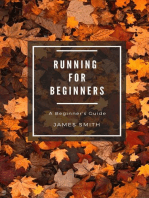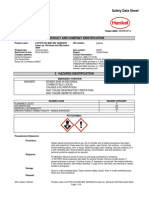Endurance in Sport Part 1
Uploaded by
Divakar GuptaEndurance in Sport Part 1
Uploaded by
Divakar GuptaINDIAN INSTITUTE OF TECHNOLOGY KANPUR
PHYSICAL EDUCATION SECTION
\
Online PE- 101AA Class On
ENDURANCE IN SPORTS –Part 1
By
Dr . Santosh Kumar Joshi & Vivek Rao Vadi
Physical Education Online course (PE-101AA), IIT Kanpur
What is Endurance ?
➢ Endurance is the ability of an athlete to withstand external physical pressures
over time, or to maintain competitive and training focus under pressure.
➢ Endurance training is the act of exercising in a way that increases the body’s
ability to withstand activity for extended periods of time. In general, this type of
exercise training refers to any type of activity that trains the aerobic energy
system as opposed to the anaerobic energy system.
➢ Endurance means a general ability to do any kind of physical activity that
increases your heart rate above 50% of your maximum.
Physical Education Online course (PE-101AA), IIT Kanpur
According to the nature of activity, the endurance is classified into
following types
➢ General Endurance: General endurance means during sports activity in the
condition of fatigue. General endurance is not specific to any sports. It is developed
through general exercise. Better the performance in sports
.
▪ Characterizes the ability of your whole body to tolerate endurance exercises and diminish fatigue.
▪ The better your general endurance the better you can stand longer efforts at various sports
disciplines.
▪ For example, if you as a 1500m runner have high level general endurance, you can perform at a
relatively high level also at 10K, but you can’t compete 10K runners who have been developing
their distance specific endurance.
Physical Education Online course (PE-101AA), IIT Kanpur
➢ Specific Endurance: Specific endurance is the ability to resist the fatigue caused
by a particular sports activity. As the nature of fatigue is different from sports to
sports, the specific endurance is different from sports to sports. For example, the
specific endurance for a wrestler is to combat effectively in three round or six
minutes, whereas it is 4 rounds for a boxer.
▪ It is the ability to stand against fatigue in sport specific conditions
▪ The better your sports specific endurance, the better you perform at this specific sport.
▪ It can be characterized as a combination of various types of endurance you need to maximize your
ability to succeed in your discipline.
▪ Basically, this is what everybody does for their own sports.
▪ For example, if you’re a 1500m runner, you use a combination of endurance training methods to
perform better at your specific distance.
Physical Education Online course (PE-101AA), IIT Kanpur
According to the duration of activity, the endurance is classified into
following types:
➢ 1.Speed Endurance:
➢ 2.Short – term Endurance:
➢ 3.Medium – term endurance:
➢ 4.Long – term endurance:
Physical Education Online course (PE-101AA), IIT Kanpur
Types of Endurance training
➢ As mentioned above, your endurance training is always a combination of different
training methods. We have listed below the main types of endurance with short
descriptions of their nature. (As there are several different classifications for
endurance training types, it should be mentioned, that the following classification
rely on the physiological processes that different intensities elicit in human body).
➢ Basic endurance:
•Intensity:
•Length:
•Rest between intervals:
•Benefits:
Physical Education Online course (PE-101AA), IIT Kanpur
➢ Tempo endurance
•Intensity:
•Length:
•Rest between intervals:
•Benefits:
➢ Maximal endurance
•Intensity:
•Length:
•Rest between intervals:
•Benefits:
Physical Education Online course (PE-101AA), IIT Kanpur
➢ Lactic speed endurance
•Intensity:
•Length:
•Rest between intervals:
•Benefits:
➢ Alactic speed endurance
•Intensity:
•Length:
•Rest between intervals:
•Benefits:
Physical Education Online course (PE-101AA), IIT Kanpur
Types of Endurance
➢ 1. Aerobic Endurance
➢ 2. Anaerobic Endurance
Physical Education Online course (PE-101AA), IIT Kanpur
➢1.Aerobic Endurance
▪ Aerobic endurance is a muscular work tempo at a pace that require predominantly oxygen as “fuel”
for muscle contractions.
▪ This oxygen based “fuel” manufacturing process is generally needed in slower muscle contractions
over longer periods such as the Marathon.
Physical Education Online course (PE-101AA), IIT Kanpur
Aerobic Threshold
➢ One tried-and-true way to measure whether you are staying in your aerobic threshold zone is to
keep an eye on your heart rate
➢ We may throw these words into conversation with our fit-minded friends from time to time –
“Hey, does your coach have you doing much aerobic threshold work this season?” – but what do
they actually mean, why does it matter, and what should you expect when it shows up on your
training plan?
➢ Let’s break it down. Here’s what athletes should understand about aerobic threshold.
➢ Generally speaking, aerobic threshold is a steady-state effort that you could perform for hours. If
you are working out in an aerobic range, your breathing will be light, and you should feel like you
can keep moving for hours.
➢ In more science-specific terms, aerobic threshold is where the level of lactate in the blood first
starts to rise and the level of effort at which anaerobic energy pathways start helping with energy
production.
Physical Education Online course (PE-101AA), IIT Kanpur
What is Aerobic Threshold Training
➢ When you are aiming to improve your aerobic threshold, the key is to emphasize low-intensity
training. Those longer steady-state workouts on your training plan – like long runs, long rides, or
steady efforts in the pool – are aerobic threshold workouts.
➢ One tried-and-true way to measure whether you’re staying in your aerobic threshold zone is to
keep an eye on your heart rate and make sure it remains in the steady, moderate effort zone for
the duration of your workout.
Why should I work on my Aerobic Threshold
For endurance athletes, having an increased aerobic threshold is key for being able to go longer and
further.
➢ A higher aerobic threshold allows you to train at higher intensity without lactate building up – in
practice, this means you can keep going at a higher intensity for a longer time.
➢ “Every athlete benefits from doing both aerobic and anaerobic workouts,” says Baugh. “The key is
balance. People usually stick to what they’re good at, or they solely train to simulate the event in
which they’re working toward.”
➢ If you’re training for a longer event, it’s important to still include short, intense interval workouts
to help your body become more efficient at burning oxygen. And for shorter efforts, having a great
aerobic base will help you recover faster between intervals.
Physical Education Online course (PE-101AA), IIT Kanpur
What is Good Aerobic Threshold
➢ Everyone’s aerobic threshold is different. Your individual aerobic fitness level determines your
heart rate on the aerobic threshold so there isn’t one specific optimal aerobic threshold.
➢ For example, the aerobic threshold of people with a poor aerobic fitness may be at 60% of their HR
max, whereas the aerobic threshold of trained athletes may be at 85% of their HR max.
So How Do I determine my Aerobic Threshold
➢ “The easiest way to determine if you’re in your aerobic energy system is to see how long you can
sustain your effort. If you are unable to maintain your effort for longer than three minutes, your
body has probably gone anaerobic,” says Baugh.
➢ So, if you are out for a run and have to drastically alter your pace within three minutes, you’re no
longer working out in the aerobic zone.
➢ By the numbers, subtract 30 beats per minute from your lactate threshold heart rate, and that’ll
give you a rough estimate of your aerobic threshold. But beyond the data, it’s the feeling at which
the intensity of your workout and effort is just slightly above resting level.
➢ A more specific method to find out what your aerobic threshold is an exercise test where the
intensity level increases step by step and the changes in the lactate concentration of your blood is
monitored with blood samples.
➢ Your aerobic and anaerobic thresholds can also be determined with an exercise test while wearing
a mask that measures your oxygen intake and the amount of CO2 in your exhale.
Physical Education Online course (PE-101AA), IIT Kanpur
➢ Some of the improvements seen with aerobic endurance training include:
• Improvements in the efficiency of the heart, respiratory and circulatory systems.
• Increased ability to absorb and transport oxygen.
• Increase efficiency of muscles to absorb and utilise oxygen.
• Increased efficiency of total energy produced through the aerobic energy systems.
• Increase the stores of key aerobic fuels (muscle glycogen, intramuscular triglycerides) and our
ability to utilise them during exercise.
• Improved fatigue resistance of our respiratory, cardiovascular, and muscular systems.
• Improvements in the VO2max, lactate threshold, exercise efficiency.
• Increased recovery during and after exercise.
• Better able to tolerate higher training loads and high intensity training.
• Increased ability to utilize lactate as a fuel source.
• Increased levels of key aerobic enzymes.
Physical Education Online course (PE-101AA), IIT Kanpur
Thank You
Physical Education Online course (PE-101AA), IIT Kanpur
You might also like
- A Partial History of Hydrofluoric Acid IncidentsNo ratings yetA Partial History of Hydrofluoric Acid Incidents17 pages
- CH 20 - Program Design and Technique For Aerobic Endurance TrainingNo ratings yetCH 20 - Program Design and Technique For Aerobic Endurance Training20 pages
- Chapter 3 - Types of Physical ActivitiesNo ratings yetChapter 3 - Types of Physical Activities97 pages
- 2.0. Aerobic & Anaerobic Endurance (Presentation)No ratings yet2.0. Aerobic & Anaerobic Endurance (Presentation)34 pages
- Topic 6 - Training The Cardiorespiratory System (Compatibility Mode)No ratings yetTopic 6 - Training The Cardiorespiratory System (Compatibility Mode)6 pages
- Low Heart Rate Benefits and HR Formula - by Mark Allen100% (2)Low Heart Rate Benefits and HR Formula - by Mark Allen15 pages
- Q4 SportsTrack Fitness and Exercise Programming12 Week1No ratings yetQ4 SportsTrack Fitness and Exercise Programming12 Week14 pages
- SPS311 - Physical Conditioning Mohd Fadzil B. HJ Kamarudin UitmNo ratings yetSPS311 - Physical Conditioning Mohd Fadzil B. HJ Kamarudin Uitm29 pages
- Principles of Aerobic Exercise: Parta Kinandana100% (1)Principles of Aerobic Exercise: Parta Kinandana30 pages
- Lecture 16 LIF101 2020 Photosynthesis INo ratings yetLecture 16 LIF101 2020 Photosynthesis I18 pages
- TA101 Lecture 23 and 24 - Development of Surfaces - 0No ratings yetTA101 Lecture 23 and 24 - Development of Surfaces - 047 pages
- Prevention of Enzymatic Browning in Fruit and Vegetables: Irina Ioannou Mohamed GhoulNo ratings yetPrevention of Enzymatic Browning in Fruit and Vegetables: Irina Ioannou Mohamed Ghoul32 pages
- CHIREC Eductional Society Salary Slip Template March 2018: S.Purushotham Kausik Legal Facilitator Academics / LegalNo ratings yetCHIREC Eductional Society Salary Slip Template March 2018: S.Purushotham Kausik Legal Facilitator Academics / Legal1 page
- Chapter 2 Basic Qualification of Security OfficerNo ratings yetChapter 2 Basic Qualification of Security Officer22 pages
- Product and Company Identification: Safety Data SheetNo ratings yetProduct and Company Identification: Safety Data Sheet6 pages
- Connecting Museums 1st Edition Mark O'Neill (Editor) 2024 scribd download100% (4)Connecting Museums 1st Edition Mark O'Neill (Editor) 2024 scribd download62 pages
- 6) Ortigas and Co. V Feati Bank-G.R. No. L-246700% (1)6) Ortigas and Co. V Feati Bank-G.R. No. L-2467011 pages






























































































